USAID and CIMMYT visit the 1st community-managed maize seed company in the hills of Nepal
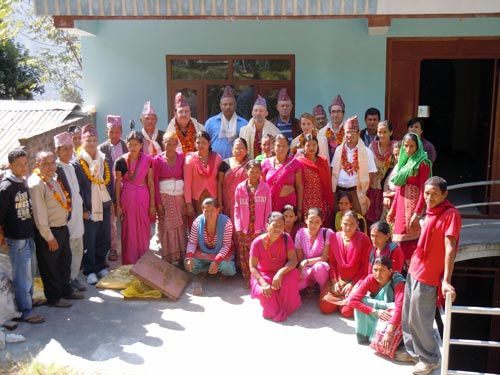 The community based seed production (CBSP) program is one of the most successful interventions of the Hill Maize Research Project (HMRP) Phase IV in Nepal. Through this program, the project has significantly contributed to the increase in maize seed replacement rate, maize productivity, and income of smallholder and resource-poor farmers in the hills of the country. To observe the successes achieved so far, teams from USAID-Nepal, CIMMYT-Mexico, and HMRP visited a community-managed seed company in the Thumpahkar Village of Sindupalchowk district, located about 100 km north-east of Kathmandu, on 12 October 2012. The USAID team comprised of John Stamm (General Development Office director, USAID-Nepal), Luis Guzman (Feed the Future team leader, USAID-Nepal), Shanker Khagi (South Asia Regional Initiative for Energy country coordinator), and Lindsey Moore (USAID-Bangladesh). CIMMYT’s Thomas Short (deputy director general for Corporate Services), Nellooli P. Rajasekharan (International Human Resources director), G. Ortiz Ferrara (HMRP team leader), Nirmal Gadal (HMRP agronomist), and Dilli KC (HMRP seed value chain and marketing expert) were also present, along with about 35 seed growers, including the management team of the company.
The community based seed production (CBSP) program is one of the most successful interventions of the Hill Maize Research Project (HMRP) Phase IV in Nepal. Through this program, the project has significantly contributed to the increase in maize seed replacement rate, maize productivity, and income of smallholder and resource-poor farmers in the hills of the country. To observe the successes achieved so far, teams from USAID-Nepal, CIMMYT-Mexico, and HMRP visited a community-managed seed company in the Thumpahkar Village of Sindupalchowk district, located about 100 km north-east of Kathmandu, on 12 October 2012. The USAID team comprised of John Stamm (General Development Office director, USAID-Nepal), Luis Guzman (Feed the Future team leader, USAID-Nepal), Shanker Khagi (South Asia Regional Initiative for Energy country coordinator), and Lindsey Moore (USAID-Bangladesh). CIMMYT’s Thomas Short (deputy director general for Corporate Services), Nellooli P. Rajasekharan (International Human Resources director), G. Ortiz Ferrara (HMRP team leader), Nirmal Gadal (HMRP agronomist), and Dilli KC (HMRP seed value chain and marketing expert) were also present, along with about 35 seed growers, including the management team of the company.
The meeting was chaired by Gunda Bahadur Dhami, chairperson of Sindhu-Tuki Seed Production Cooperative Ltd. During a brief presentation, the company’s coordinator D.B. Bhandari summarized the institutional graduation of the farmers’ groups to a cooperative and later to a private seed company. Starting in 2005, the cooperative developed into a private seed company in 2010 with the technical support from HMRP. It currently works with 300 members organized in 14 CBSP groups. Bhandari also discussed the company’s current activities, future plan, operational model, membership policy, marketing activities, and approaches to gender and sustainability.
Stamm acknowledged the project team and congratulated farmers on the impact achieved so far. “USAID-Nepal considers HMRP a very successful project, and your seed company is a model for economic development of rural areas,” he said. Rajasekharan then thanked the HMRP team for organizing the field visit and expressed CIMMYT’s commitment to support the project staff in their work aiming to improve food security among Nepalese maize farmers. Short added: “I echo Raj’s words in congratulating the members of this seed company, but I also take the opportunity to thank the two donors of HMRP, USAID and SDC, for their financial and technical support given to the project.” Ortiz Ferrara stressed that “sustainability is the prime concern of HMRP, and the entire project activities are built on the clearly defined roles and responsibilities of the multiple stakeholders.
This small seed company is now operating on its own resources, and this is only one of the 195 CBSP groups coordinated by HMRP in 20 hill districts.” Responding to a question raised by Khagi regarding the competitiveness of improved maize seed, a female maize seed grower said: “The new maize varieties are high yielding, disease and lodging tolerant, have good taste, and the grain can be stored for a longer time.” Dhami followed: “We are just learning to walk and there is still a lot to do to help small farmers in our hill area to achieve food security and increase their income.” He thanked the guests for their valuable time and their continuing collaboration with the recently established seed company. At the end of the discussion, the team observed the seed processing plant, seed store house, and the community seed bank.
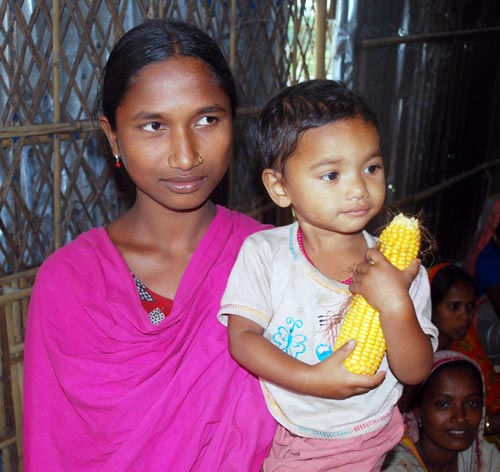 The U.S. Agency for International Development (
The U.S. Agency for International Development ( The Hill Maize Research Project (
The Hill Maize Research Project (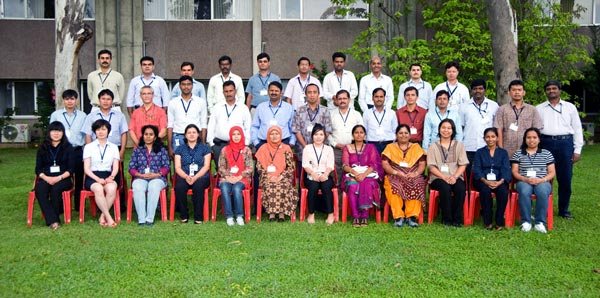
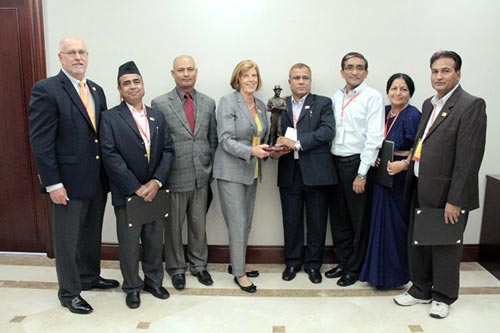 The first-ever
The first-ever 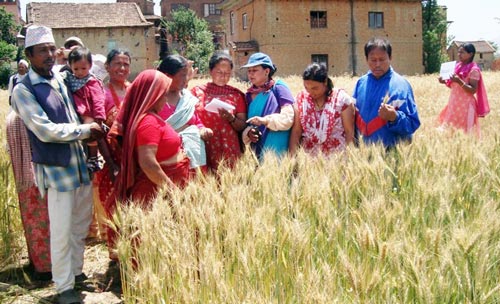 On 14 May 2012, at Tikathali, Changathali Village Development Committee Centre (VDC) in Lalitpur, around 30 participants from MoA, NARC, seed companies, and CIMMYT were joined by 61 farmers (43 female, 18 male) and several graduate students and technicians. The event also saw active participation from senior district agriculture development officers from Lalitpur, Bhaktapur, and Kathmandu as well as the Crop Development Directorate of Nepal and the Seed Quality Control Center.
On 14 May 2012, at Tikathali, Changathali Village Development Committee Centre (VDC) in Lalitpur, around 30 participants from MoA, NARC, seed companies, and CIMMYT were joined by 61 farmers (43 female, 18 male) and several graduate students and technicians. The event also saw active participation from senior district agriculture development officers from Lalitpur, Bhaktapur, and Kathmandu as well as the Crop Development Directorate of Nepal and the Seed Quality Control Center.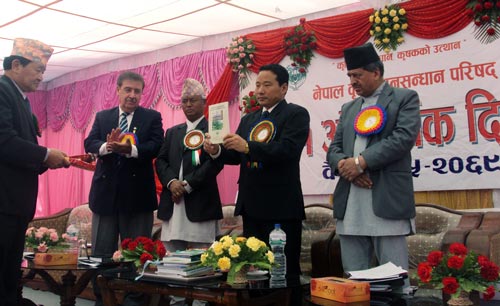 The gathering brought together more than 275 scientists and development workers. “The Nepal Government is planning to raise the budget for agriculture significantly in the upcoming national budget plan” said Pun. “There is also a need to adopt enhanced technology to double agricultural production and to attract youth to the sector,” he added. Pun also mentioned that “the Prime Minister and his Government are committed to giving top priority to farming as it is the only way to alleviate poverty and ensure employment for a larger section of society”.
The gathering brought together more than 275 scientists and development workers. “The Nepal Government is planning to raise the budget for agriculture significantly in the upcoming national budget plan” said Pun. “There is also a need to adopt enhanced technology to double agricultural production and to attract youth to the sector,” he added. Pun also mentioned that “the Prime Minister and his Government are committed to giving top priority to farming as it is the only way to alleviate poverty and ensure employment for a larger section of society”.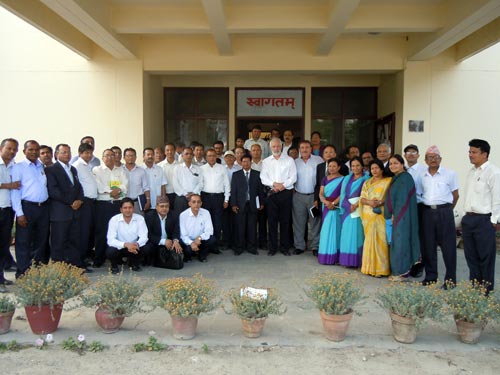 CIMMYT director general Thomas Lumpkin visited Nepal during 01-03 May 2012. One of the main objectives of his visit was to discuss the Borlaug Institute for South Asia (BISA) launched last year in India, and the potential for Nepal to follow a similar model, with Nepal Agricultural Research Council (NARC) and CIMMYT scientists.
CIMMYT director general Thomas Lumpkin visited Nepal during 01-03 May 2012. One of the main objectives of his visit was to discuss the Borlaug Institute for South Asia (BISA) launched last year in India, and the potential for Nepal to follow a similar model, with Nepal Agricultural Research Council (NARC) and CIMMYT scientists.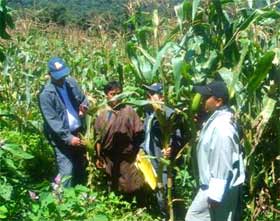 Sandwiched between China and India, the Kingdom of Bhutan is a small country that relies on maize in a big way. But maize yields are typically low due to crop diseases, drought, and poor access to seed of improved varieties, among other reasons. CIMMYT is committed to improving Bhutan’s food security by providing high-yielding, pest-resistant maize varieties to farmers and capacity-building for local scientists.
Sandwiched between China and India, the Kingdom of Bhutan is a small country that relies on maize in a big way. But maize yields are typically low due to crop diseases, drought, and poor access to seed of improved varieties, among other reasons. CIMMYT is committed to improving Bhutan’s food security by providing high-yielding, pest-resistant maize varieties to farmers and capacity-building for local scientists.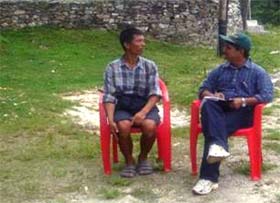
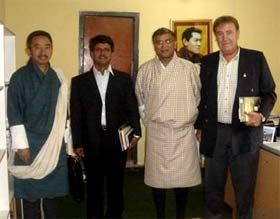 “Our CIMMYT office in Nepal has assisted Bhutan with maize and wheat genetic material, technical backstopping, training, visiting scientist exchange, and in identifying key consultants on research topics such as grey leaf spot and seed production,” says Tiwari.
“Our CIMMYT office in Nepal has assisted Bhutan with maize and wheat genetic material, technical backstopping, training, visiting scientist exchange, and in identifying key consultants on research topics such as grey leaf spot and seed production,” says Tiwari.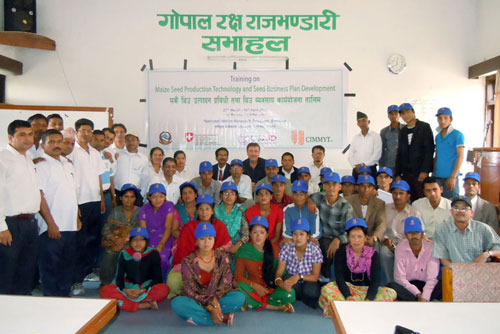
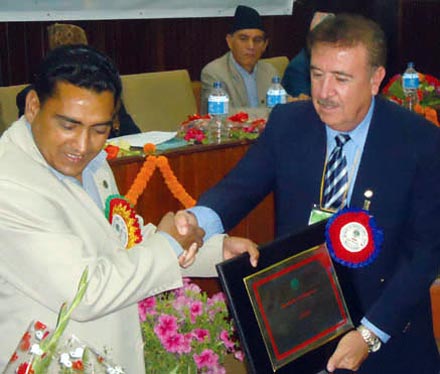 Receiving the prize on behalf of CIMMYT, Nepal country representative Guillermo Ortiz-Ferrara thanked the Society for the recognition. “On behalf of the director general of CIMMYT, Dr. Thomas Lumpkin, the center’s management, and colleagues who have been based in Nepal and the region for more than 26 years, we thank SAS-N for this great honor,” he said. “I would like to give special thanks to the government of Nepal and the MoAC for hosting CIMMYT’s regional office. Finally, we thank the many government and non-government organizations for their long-standing partnership and collaboration.”
Receiving the prize on behalf of CIMMYT, Nepal country representative Guillermo Ortiz-Ferrara thanked the Society for the recognition. “On behalf of the director general of CIMMYT, Dr. Thomas Lumpkin, the center’s management, and colleagues who have been based in Nepal and the region for more than 26 years, we thank SAS-N for this great honor,” he said. “I would like to give special thanks to the government of Nepal and the MoAC for hosting CIMMYT’s regional office. Finally, we thank the many government and non-government organizations for their long-standing partnership and collaboration.”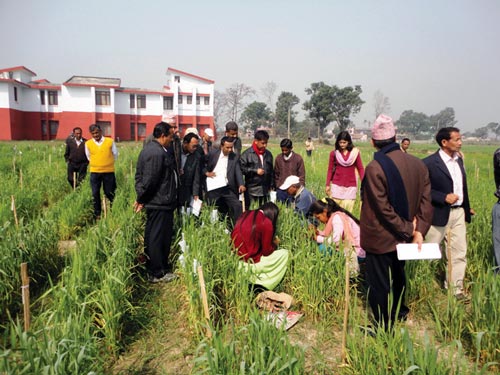 A training program on wheat participatory variety selection (PVS) was held in Nepal during 28-29 February 2012. Organized by the National Wheat Research Program (NWRP), Bhairahawa, Nepal Agriculture Research Council (NARC) and CIMMYT, the event attracted 17 scientists, technical officers and seed technicians from NARC’s research stations and private seed companies. The two-day training program focused on current challenges of wheat breeding and production in Nepal, wheat diseases, and participatory selection of varieties.
A training program on wheat participatory variety selection (PVS) was held in Nepal during 28-29 February 2012. Organized by the National Wheat Research Program (NWRP), Bhairahawa, Nepal Agriculture Research Council (NARC) and CIMMYT, the event attracted 17 scientists, technical officers and seed technicians from NARC’s research stations and private seed companies. The two-day training program focused on current challenges of wheat breeding and production in Nepal, wheat diseases, and participatory selection of varieties.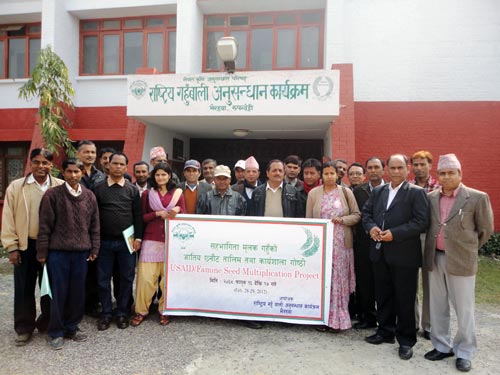 NARC scientists SR Upadhyay and NR Gautam explained the steps of participatory selection and participants scored varieties in the mother trial.
NARC scientists SR Upadhyay and NR Gautam explained the steps of participatory selection and participants scored varieties in the mother trial.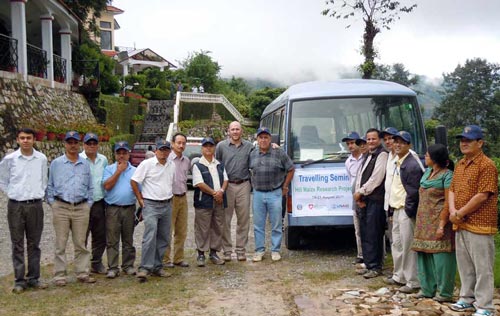 During 19-21 August 2011, a travelling seminar on “Maize Research and Development in the Hills of Nepal” was organized by the CIMMYT-led Hill Maize Research Project (HMRP), Nepal Agricultural Research Council (NARC), and the Nepal Department of Agriculture (DoA). The seminar offered policy makers first-hand information on maize varietal development, seed multiplication, technology dissemination, and HMRP’s efforts to improve food security and livelihoods of small-scale and disadvantaged farmers in the region. The 25 participants included representatives from the National Planning Commission, Ministry of Agriculture and Cooperatives, National Seed Board, NARC, DoA, donors (SDC and USAID), and NGOs.
During 19-21 August 2011, a travelling seminar on “Maize Research and Development in the Hills of Nepal” was organized by the CIMMYT-led Hill Maize Research Project (HMRP), Nepal Agricultural Research Council (NARC), and the Nepal Department of Agriculture (DoA). The seminar offered policy makers first-hand information on maize varietal development, seed multiplication, technology dissemination, and HMRP’s efforts to improve food security and livelihoods of small-scale and disadvantaged farmers in the region. The 25 participants included representatives from the National Planning Commission, Ministry of Agriculture and Cooperatives, National Seed Board, NARC, DoA, donors (SDC and USAID), and NGOs.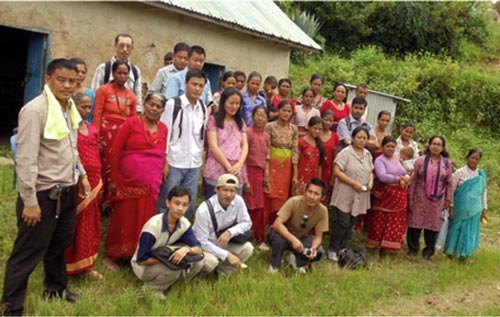 The following day featured a visit to the Hill Crop Research Program (HCRP), Kabre, Dolakha. Participants observed the onsite maize research and development activities, such as source seed production of improved maize varieties, and had the opportunity to interact with scientists at the station. N.P. Adhikari, Director of Crops and Horticulture, NARC, and D.B. Gurung, National Maize Coordinator, complimented the scientists for their accomplishments in maize research and development, both at the station and in the field.
The following day featured a visit to the Hill Crop Research Program (HCRP), Kabre, Dolakha. Participants observed the onsite maize research and development activities, such as source seed production of improved maize varieties, and had the opportunity to interact with scientists at the station. N.P. Adhikari, Director of Crops and Horticulture, NARC, and D.B. Gurung, National Maize Coordinator, complimented the scientists for their accomplishments in maize research and development, both at the station and in the field.